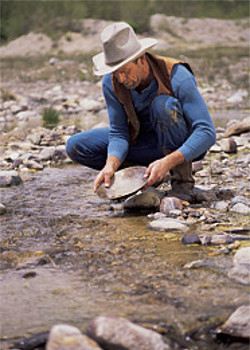 Prospecting is searching for gold deposits that can be profitably
mined. If a good deposit is found, the prospector will
get a claim
covering the area and either mine it or sell it.
Prospecting is searching for gold deposits that can be profitably
mined. If a good deposit is found, the prospector will
get a claim
covering the area and either mine it or sell it.
Prospecting is done in Placer Areas so that the prospector can get a claim.
Exploration means pretty much the same thing as prospecting. Either one can mean exploring a large area or focusing on a smaller area or claim.
See Where Gold is Found in a Creek or River, which is on the Gold Panning page.
When working in a stream channel in BC, the prospector must follow the rules of Hand Panning.
"Colors" (tiny flakes of gold) in the pan mean that there is (or was) more gold above and/or upstream.
If a creek looks promising, it might be followed upstream (or the prospector might drive to a location upstream) to see if the creek gets richer, to see if there is a point beyond which the creek is not gold-bearing, and perhaps to see which tributaries (streams that join the original stream) are gold-bearing.
 Other than hand panning using only a shovel and pan,
placer operations must be
at least ten metres
horizontally away from the water (although the
Fraser River
is a special case). So...
Other than hand panning using only a shovel and pan,
placer operations must be
at least ten metres
horizontally away from the water (although the
Fraser River
is a special case). So...
Once a creek is discovered (or already known) to be gold bearing, the focus of prospecting is generally on where it flowed long ago. This means...
The effect of ice ages may be considered. Vast amounts of glacial melt-water is usually responsible for moving most of the material that partially fills a valley, giving it a flat bottom (not a U-shaped bottom). See A Little Geology - Valley Shape for more information.
Drilling is often done prior to more expensive machine digging. This kind of drilling is like water-well drilling - material is recovered, but except at the bottom, you usually don't know the exact depth of any particular material.
Digging test pits and trenches with a hoe/excavator to get samples is common.
Samples can be tested by:
All images on this website are copyrighted by their owners and they may not be downloaded for other than personal use - republication, retransmission, reproduction or other use is prohibited.
Note: This page may contain images from FREEBigPictures.com.
INFORMATION PROVIDED BY THIS WEBSITE IS PROVIDED "AS IS", WITHOUT WARRANTY OF ANY KIND, EXPRESS OR IMPLIED, INCLUDING BUT NOT LIMITED TO THE WARRANTIES OF ACCURACY, MERCHANTABILITY, FITNESS FOR A PARTICULAR PURPOSE AND NON-INFRINGEMENT. USE AT YOUR OWN RISK.